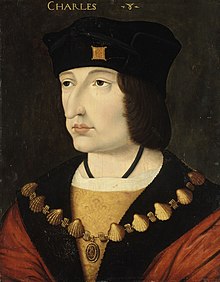
Back Karel VIII van Frankryk Afrikaans Carlos VIII de Francia AN شارل الثامن ملك فرنسا Arabic شارل التامن ملك فرنسا ARZ Carlos VIII de Francia AST Charles VIII (gazik ke Franca) AVK VIII Karl (Fransa kralı) Azerbaijani سککیزینجی شارل AZB Карл VIII Валуа Byelorussian Шарл VIII Bulgarian
| Charles VIII | |
|---|---|
 16th-century portrait | |
| King of France | |
| Reign | 30 August 1483 – 7 April 1498 |
| Coronation | 30 May 1484 (Reims) |
| Predecessor | Louis XI |
| Successor | Louis XII |
| Regent | Anne of France and Peter II, Duke of Bourbon (1483–1491) |
| Born | 30 June 1470 Château d'Amboise, France |
| Died | 7 April 1498 (aged 27) Château d'Amboise, France |
| Burial | 1 May 1498 |
| Spouse | |
| Issue more... | Charles Orlando, Dauphin of France |
| House | Valois |
| Father | Louis XI of France |
| Mother | Charlotte of Savoy |
| Signature |  |
Charles VIII, called the Affable (French: l'Affable; 30 June 1470 – 7 April 1498), was King of France from 1483 to his death in 1498. He succeeded his father Louis XI at the age of 13. His elder sister Anne acted as regent jointly with her husband Peter II, Duke of Bourbon until 1491, when the young king turned 21 years of age. During Anne's regency, the great lords rebelled against royal centralisation efforts in a conflict known as the Mad War (1485–1488), which resulted in a victory for the royal government.
In a remarkable stroke of audacity, Charles married Anne of Brittany in 1491 after she had already been married by proxy to the Habsburg Holy Roman Emperor Maximilian I in a ceremony of questionable validity. Preoccupied by the problematic succession in the Kingdom of Hungary, Maximilian failed to press his claim. Upon his marriage, Charles became administrator of Brittany and established a personal union that enabled France to avoid total encirclement by Habsburg territories.
To secure his rights to the Neapolitan throne that René of Anjou had left to his father, Charles made a series of concessions to neighbouring monarchs and, due to his revolutionary artillery, conquered the Italian peninsula without much opposition. A coalition formed against the French invasion of 1494–98 attempted to stop Charles' army at Fornovo, but failed and Charles marched his army back to France.
Charles died in 1498 after accidentally striking his head on the lintel of a door at the Château d'Amboise, his place of birth. Since he had no male heir, he was succeeded by his second cousin once removed and brother-in-law at the time, Louis XII, from the Orléans cadet branch of the House of Valois.
© MMXXIII Rich X Search. We shall prevail. All rights reserved. Rich X Search